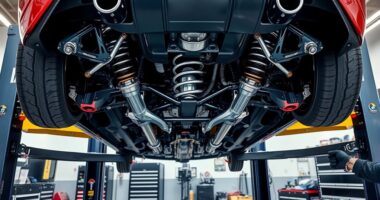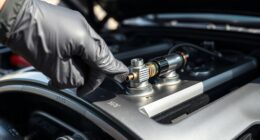If you’re modifying a vehicle in Europe, you must follow strict regulations on emissions, noise levels, safety, and approval processes. This includes guaranteeing your modifications meet EU standards, obtaining necessary approvals from national authorities like TÜV or the Ministry of Transport, and keeping proper documentation. Inspections by authorized agencies verify compliance, and unauthorized changes can lead to fines or legal issues. Keep in mind, compliance varies by country—stay informed to avoid risks and ensure your vehicle meets all requirements.
Key Takeaways
- All modifications must meet national and EU safety, emission, and noise standards, with proper certification and approval processes.
- Vehicle alterations require documentation such as type approval, certificates, and compliance proof from authorized testing bodies.
- Modifications affecting vehicle structure, emissions, or noise levels must pass inspections by certified agencies like TÜV or DEKRA.
- Unauthorized or non-compliant modifications can lead to fines, vehicle seizure, revoked registration, and legal liability.
- Insurance policies must be updated to reflect modifications; failure to declare changes may void coverage or increase premiums.
Understanding EU Emissions and Noise Standards
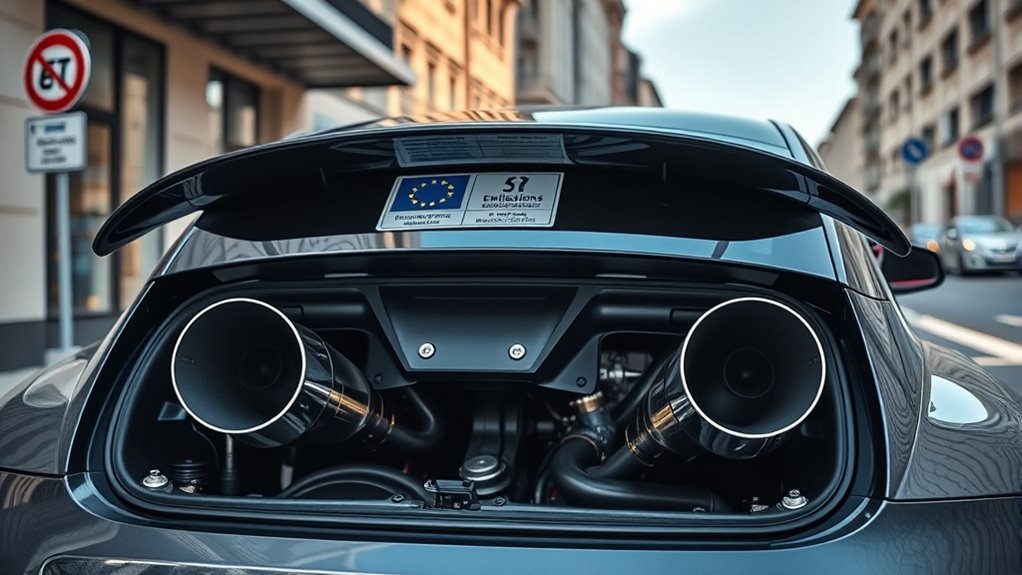
Understanding EU emissions and noise standards is essential if you’re involved in modifying vehicles or planning to sell them in Europe. These regulations set strict limits on pollutants and noise levels to reduce environmental impact. For example, by 2035, the EU aims for a fleet-wide CO₂ emission of 0 g/km for new cars and vans, with intermediate targets like a 15% reduction between 2025 and 2029. Heavy-duty vehicles also face ambitious goals, with reductions up to 90% by 2040. Euro standards, especially Euro 7, regulate pollutants and particulates, extending lifetime emission limits. Noise standards require vehicles to undergo testing and meet specific limits for both stationary and in-motion conditions. Non-compliance can lead to penalties, making it crucial to understand and adhere to these evolving regulations. Additionally, implementing fraud detection techniques in transaction processing can serve as a useful analogy for the importance of strict compliance and monitoring in vehicle regulation enforcement. Moreover, regular emission level assessments are vital to identify potential violations early and ensure ongoing compliance throughout a vehicle’s lifecycle. Continuous noise emission monitoring is also necessary to verify compliance with noise standards over time and prevent violations. Staying informed about regulatory updates helps vehicle owners and manufacturers adapt quickly to new standards and avoid costly penalties.
Country-Specific Vehicle Modification Regulations

Vehicle modification regulations vary markedly across European countries, and staying compliant is essential to avoid penalties or vehicle confiscation. In Germany, you need TÜV approval under §33 KFG for most modifications, with strict noise, tinting, suspension, and lighting rules. Post-1989 vehicles are limited to 74 decibels, and front window tinting must allow at least 70% light transmission. In Italy, modifications require approval from the Ministry of Transport and must meet engine, noise, and emission standards, with structural integrity strictly maintained. Spain’s regulations, overseen by the Ministry of Industry, prohibit alterations that compromise original specifications or safety features. Always remember, EU-wide rules like Regulation 2018/858 emphasize safety and environmental standards, but national laws can impose additional restrictions. Staying informed ensures your vehicle remains legal and safe across borders. Additionally, innovative and wicked planters can be used to customize your vehicle’s interior for a unique look, provided they meet safety standards. Moreover, understanding vehicle modification standards can help you navigate these complex regulations more effectively, especially regarding headphone compatibility and safety considerations for vehicle audio systems.
Approval Processes for Vehicle Modifications in Europe
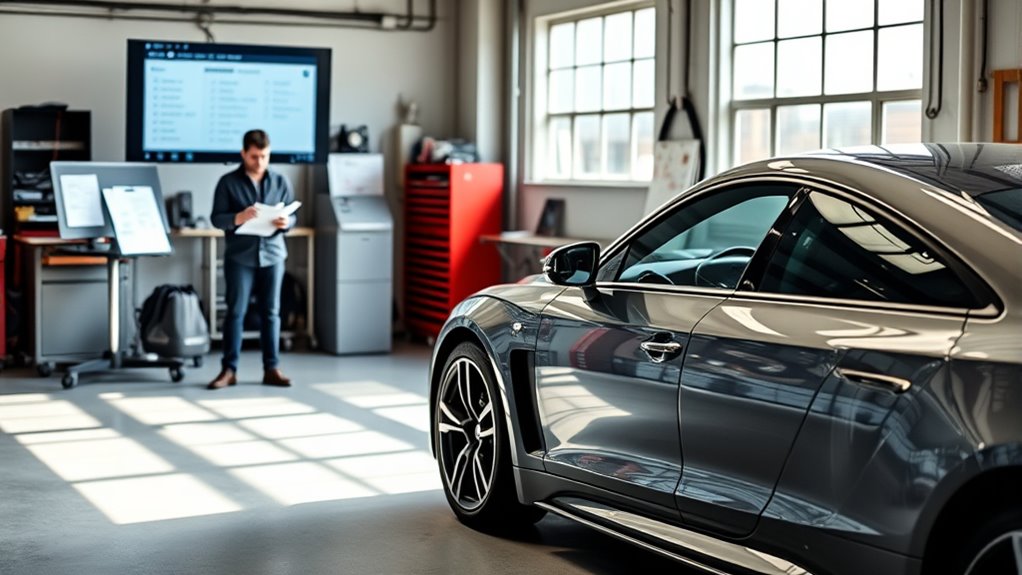
Have you ever wondered how modifications to your vehicle are approved across Europe? The approval process involves making certain your vehicle meets safety and environmental standards through type approval. In the EU, manufacturers obtain certificates after testing against harmonized standards, emphasizing independence and consistency. If you modify your vehicle, you might need additional approval, especially if the changes affect safety or emissions. In the UK, you’ll encounter procedures like provisional GB approval, IVA for significant modifications, or voluntary approval for registered vehicles. Each country has specific regulations, and inspections are carried out by authorized engineers. To stay compliant, you’ll need proper documentation and certificates for your modifications. This process helps prevent legal issues, ensures safety, and guarantees your vehicle remains roadworthy across different European regions, with the approval process often involving detailed documentation and adherence to standards. Regular updates on regulatory requirements are essential to ensure ongoing compliance. Additionally, staying informed about vehicle modification laws in each country can help prevent penalties or the need for costly rework. Understanding the importance of standardization can further streamline the approval process and reduce potential complications.
Required Documentation for Modified Vehicles
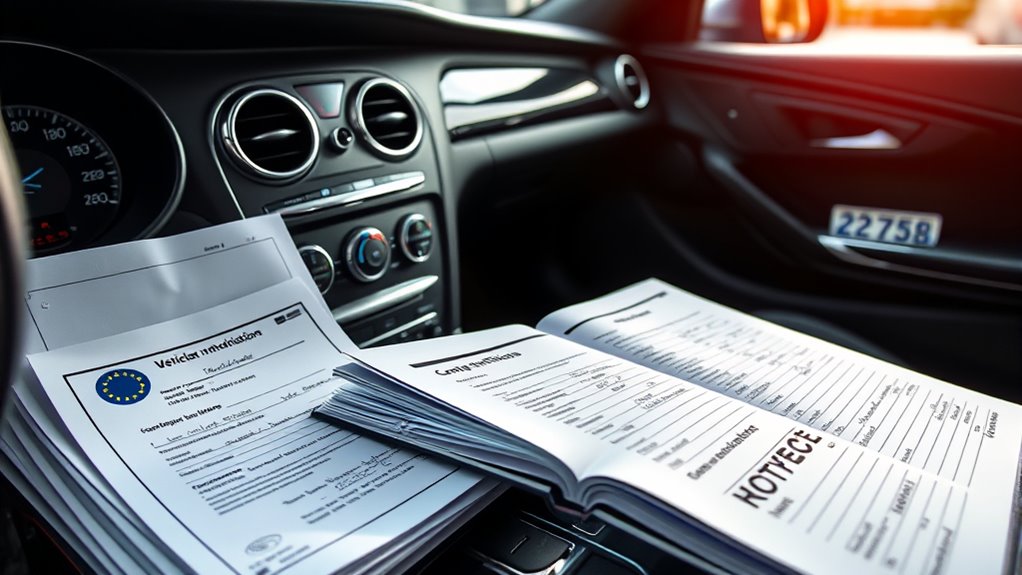
When you modify a vehicle in Europe, providing the correct documentation is essential to guarantee your changes are approved and legally recognized. You’ll need your vehicle registration certificate or part 1 of it to start the process. For parts without a general operating permit (ABE), you must obtain parts certificates, and certain modifications require an ABE to prove compliance with standards. If your changes alter the vehicle’s type or performance, a type approval or manufacturer’s certificate is necessary. Technical reports and conformity documents may also be required depending on the complexity of your modifications. Additionally, you’ll need proof of ownership, valid insurance, and possibly VAT payment evidence. For new or heavily modified vehicles, a certificate of conformity is often mandatory to ensure your vehicle meets European regulations. Proper documentation ensures the modification aligns with home decor & design standards and enhances vehicle safety. Ensuring your modifications meet European vehicle regulations can prevent legal issues during inspections or resale. Being aware of specific modification requirements can also streamline the approval process and avoid delays. Furthermore, understanding the approval procedures involved can help expedite the certification process. Consulting with authorized inspection bodies or regulatory agencies can provide clarity on compliance standards and reduce the risk of non-conformity.
Vehicle Inspection and Compliance Checks
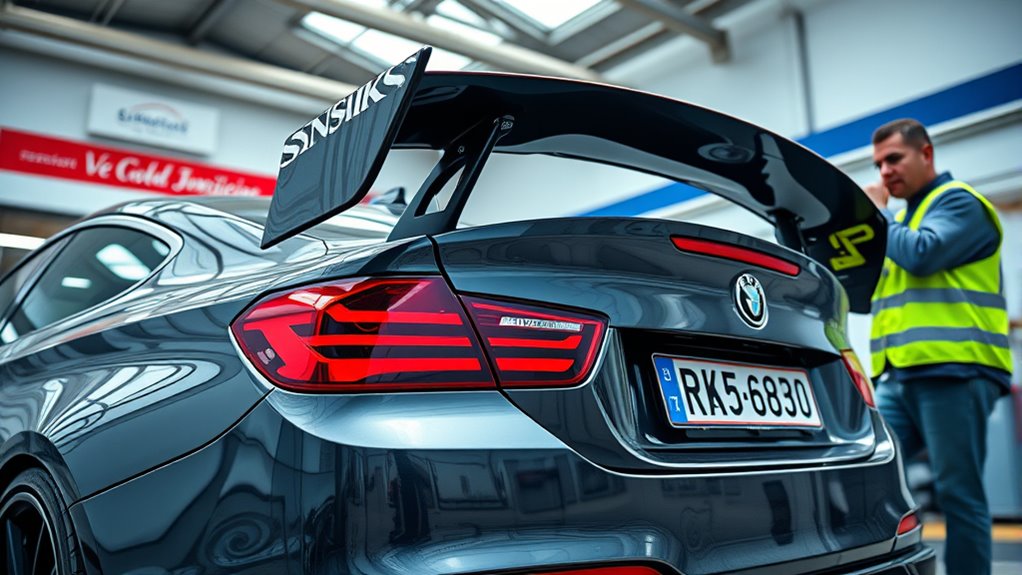
Are you aware of the inspection process necessary to guarantee your modified vehicle complies with European standards? When you get your vehicle inspected, several steps ensure compliance:
- You’ll visit authorized entities like DEKRA or TÜV, where inspectors verify modifications.
- They assess emissions, noise levels, and structural integrity, often using dyno tests and diagnostics.
- Depending on the outcome, your vehicle receives one of four results: no faults, minor faults, major faults, or severe faults.
- If faults are found, repairs are required, and re-inspection is needed before registration approval.
- Practicing mindfulness and presence during inspections can help you stay calm and focused throughout the process.
- Staying informed about vehicle inspection procedures can streamline the compliance process and reduce delays.
Unauthorized modifications can lead to registration revocation, so timely inspections and proper documentation are vital. Ensuring your vehicle’s regulatory compliance is essential for maintaining its legality and safety across Europe. Staying compliant ensures your vehicle remains legal, safe, and insurable across Europe.
Safety Standards and Structural Integrity

Ensuring your modified vehicle meets safety standards and maintains structural integrity is essential for legal road use across Europe. You must verify crashworthiness, reinforced crumple zones, and safety glass to protect occupants and pedestrians. Tyre pressure monitoring guarantees optimal grip, while advanced emergency braking helps prevent collisions. Load-bearing modifications need stress testing to ensure chassis stability. Here’s a quick overview:
| Safety Requirement | Purpose |
|---|---|
| Crashworthiness standards | Protect occupants during accidents |
| Safety glass | Reduce glass injuries in collisions |
| Tyre pressure monitoring | Maintain grip and braking performance |
| Load-bearing stress tests | Ensure chassis stability with modifications |
Meeting these standards ensures your vehicle remains safe, compliant, and roadworthy across Europe.
The Role of Certification Bodies and Inspection Agencies
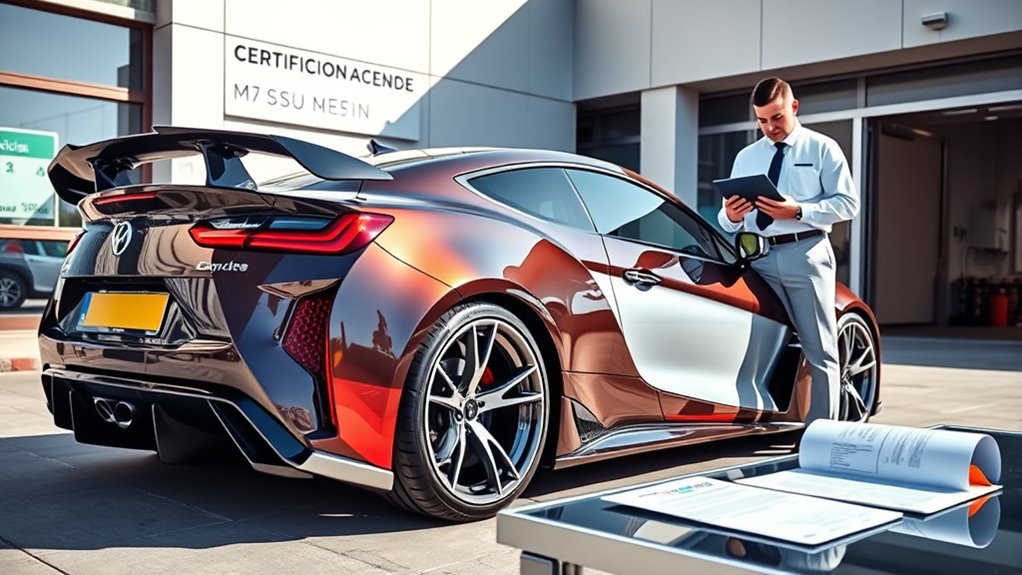
Certification bodies and inspection agencies play a crucial role in maintaining vehicle safety and compliance across Europe. They ensure that vehicles meet safety, environmental, and technical standards. Here’s how they contribute:
- Certification bodies, like the Vehicle Certification Agency (VCA), issue approvals and verify standards adherence.
- Designated technical services conduct tests on behalf of authorities to confirm compliance.
- Inspection agencies perform independent checks to verify modifications meet national and EU regulations.
- These agencies ensure all documentation is accurate, helping maintain safety and transparency in the approval process.
Legal Implications of Unauthorized Modifications

Unauthorized vehicle modifications can lead to serious legal consequences across Europe, especially when they exceed manufacturer specifications or violate national regulations. If you make changes like engine remaps, exhaust upgrades, or structural alterations without approval, authorities may impose fines, seize your vehicle, or require you to restore it to compliance. In some countries, non-compliant mods can result in registration revocation or legal liability if you’re involved in an accident caused by the modification. Police might also order repairs or enforce strict inspections, and you could face criminal charges for safety or environmental violations. Additionally, unapproved modifications can void warranties and lower resale value. Be aware that what’s legal in one country might be illegal elsewhere, so understanding regional regulations is essential to avoid penalties and legal trouble.
Insurance Considerations for Modified Vehicles

Have you ever considered how modifying your vehicle can affect your insurance coverage? If not, you risk losing protection when you need it most. Here are key points to keep in mind:
- Declare all modifications: Inform your insurer about any change, big or small.
- Understand risk assessment: Insurers evaluate how modifications influence safety, performance, and value.
- Avoid policy invalidation: Failing to disclose modifications can invalidate your coverage.
- Expect premium adjustments: More risks or increased vehicle value typically lead to higher premiums.
Specialized policies for modified cars are often necessary, offering coverage tailored to your vehicle’s upgrades. Always review your policy annually and work with brokers experienced in modified vehicles to ensure you stay protected and compliant.
Tips for Staying Compliant With European Vehicle Laws

Staying compliant with European vehicle laws requires careful attention to regulations that vary across countries but are unified by EU standards. To keep your modified vehicle legal, research each country’s specific rules, especially emissions, noise, and structural integrity. Always use approved parts with certificates or general operating permits to simplify approval processes. When making modifications, document everything thoroughly and register changes with the authorities. Regularly pass inspections like TÜV or GTÜ, especially for suspension or engine mods. Remember, non-compliance can lead to fines or vehicle confiscation. Use the following table to understand key regional differences:
| Aspect | Germany | Spain | Italy |
|---|---|---|---|
| Emissions Standards | EU standards apply | EU standards apply | EU standards apply |
| Noise Regulations | Max 74 dB (post-1989) | Not specified | Not specified |
| Structural Integrity | No compromise allowed | No modifications affecting | Not specified |
Frequently Asked Questions
Can I Legally Modify My Vehicle’s Exhaust System in Europe?
You can modify your vehicle’s exhaust system in Europe, but you need to guarantee it meets strict regulations. Check that the system has TÜV or EC approval, complies with emissions and noise limits, and isn’t designed to increase noise pollution. Also, avoid removing sound-dampening devices like DB Killers. If you follow these rules, your modifications can be legal, helping you stay compliant and avoid fines.
Are Aftermarket Wheels Automatically Approved Across All European Countries?
You might wonder if aftermarket wheels are automatically approved across Europe. The truth is, they’re not. Each country has its own rules, and wheels need to meet specific standards like EU regulations, E-markings, or national approvals such as NAD in Italy. Without proper certification, your wheels might not be legal. Always check local laws and guarantee your wheels have the required certifications before crossing borders.
How Do I Obtain Approval for Engine Modifications in Different EU Nations?
To get approval for engine modifications in EU countries, you’ll need to start by checking each country’s specific rules. Generally, you must submit detailed documentation of your modifications, verify they meet emissions and safety standards, and get certification from authorized bodies like TÜV in Germany or equivalent organizations elsewhere. Keep in mind, non-compliance can lead to fines or vehicle restrictions, so stay updated on local regulations.
What Are the Penalties for Unregistered Vehicle Modifications in Europe?
You need to know that unregistered vehicle modifications in Europe can lead to hefty fines, vehicle confiscation, and operational bans. For example, Germany imposes fines up to €30,000, and France may ban imports unless factory-standard. You also risk losing insurance coverage and facing criminal charges for serious violations. Repeated offenses can restrict your vehicle’s use or result in further legal actions, so always guarantee modifications are properly registered and compliant.
Do Electric Vehicles Have Different Modification Regulations Compared to Traditional Cars?
When it comes to modifying electric vehicles versus traditional cars, you’ll find distinct rules, specific standards, and unique safety considerations. EV modifications focus on electrical safety, high-voltage systems, and battery placement, while traditional cars deal more with emissions and mechanical parts. You must guarantee structural integrity, meet homologation standards, and follow safety protocols for high-voltage systems. These differences reflect the specialized technology and regulatory focus on electrical safety inherent to EVs.
Conclusion
Managing vehicle modifications in Europe is like steering through a carefully charted map—each regulation a guiding star ensuring your journey remains lawful and safe. By respecting standards and securing proper approvals, you protect your vehicle’s integrity and your peace of mind. Remember, compliance isn’t just a legal obligation; it symbolizes your commitment to responsible motoring. Stay informed, stay compliant, and let your vehicle’s true spirit shine within the boundaries of European law.





